By the late ’80s, the Space Age inspired Tomorrowlands in both Anaheim (dating to 1967) and Orlando (1971) were out of sync with pop culture, and badly needed revived once more. But endless investment in futile futurism was not sustainable, and a new model was needed if the concept of Tomorrowland stuck around. Luckily, an Imagineering experiment in progress gave reason for hope…
Disneyland Paris: Discoveryland (1992)
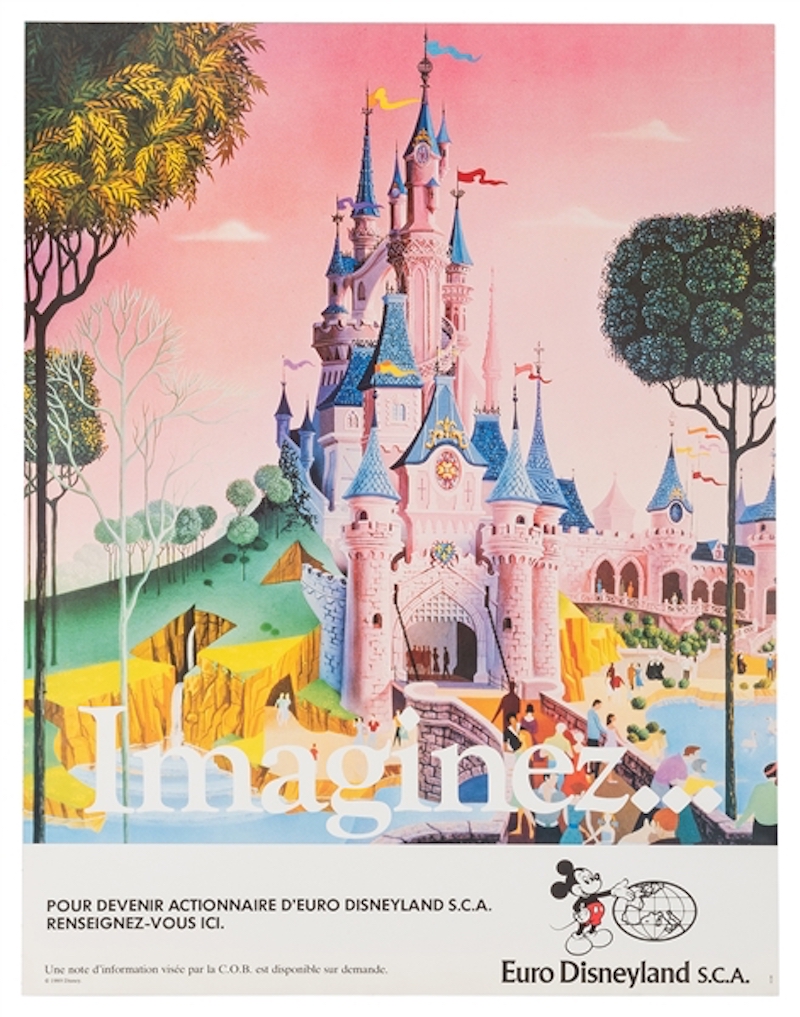
Across the Atlantic, Imagineers were hard at work on EuroDisneyland – a park that would forever change the face of Disney. Given the outright contempt that the French media had displayed around the Parisian park, Imagineers were tasked with doing something they’d never done before: stripping the Americana out of the inherently-American concept of Disneyland. And it makes sense, doesn’t it? A Tomorrowland of swirling NASA-inspired rockets and Space Age iconography would be pretty meaningless to Europeans.
So designers did something amazing. EuroDisneyland opened without a Tomorrowland at all. In its place stood Discoveryland (interpolating elements of the never-built Possibilityland: Discovery Bay once planned for Disneyland). Rather than being stylized after modern (and ever-changing) ideas of tomorrow, this golden, literary seaport was instead a fantasy future based on ideas from the past.

Discoveryland is the future as it was envisioned from the past… It’s tomorrow as it was imagined by late 1800s European writers like H.G. Wells and Jules Verne – a steampunk-stylized world of spinning astrolabes, docked zephyrs, iron bridges, Captain Nemo’s Nautilus, and Victorian daydreams of science. Unlike the sterile, white scientific Tomorrowland, Discoveryland presented a European fantasy future; a world at one with nature, derived from literature, and anchored by the sensational, epic, one-of-a-kind Lost Legend: Space Mountain – De la Terre á la Lune.
A-ha! There was the answer! Discoveryland had solved the Tomorrowland problem! By bringing to life a future envisioned from the past, this new take on Tomorrowland had entirely avoided the messiness of making real predictions, keeping current with cutting edge concepts, or stylizing a land with ever-changing tastes of architecture. Discoveryland was timeless; it was evergreen; it would never need an expensive, floor-to-ceiling redesign! And just like that, Imagineers were tasked with designing similarly timeless Tomorrowlands for Florida and California…
Magic Kingdom: New Tomorrowland (1994)
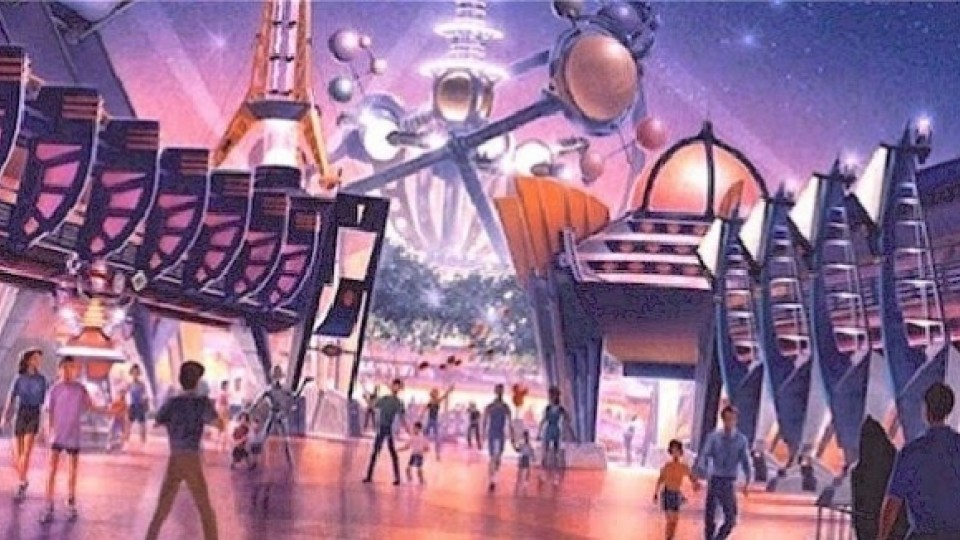
“The future that never was is finally here.” At least, that was the promise set forth by Magic Kingdom’s New Tomorrowland, debuting in 1994. Whereas Paris’ Discoveryland had been a fantasy future based on late 19th century literature, Magic Kingdom’s would be a science fiction future as envisioned in early 20th century pulp comic books. Metallic fins, neon signs in exterrestrial languages, metallic palm trees, robotic newsboys, docked alien saucers, and glowing silver accents swept across the land, crafting a clever way to make Tomorrowland timeless.
Amazingly ambitious, this vast New Tomorrowland was one of Imagineering’s first attempts at a modern, immersive themed land. This Tomorrowland wasn’t just a vague collection of buildings with sci-fi architecture; it was a “real” place with a mythology all its own, and an overarching design aesthetic and frame story connecting each ride, show, and restaurant within. And believe it or not, the park’s Peoplemover was one of the central elements of that world-building.
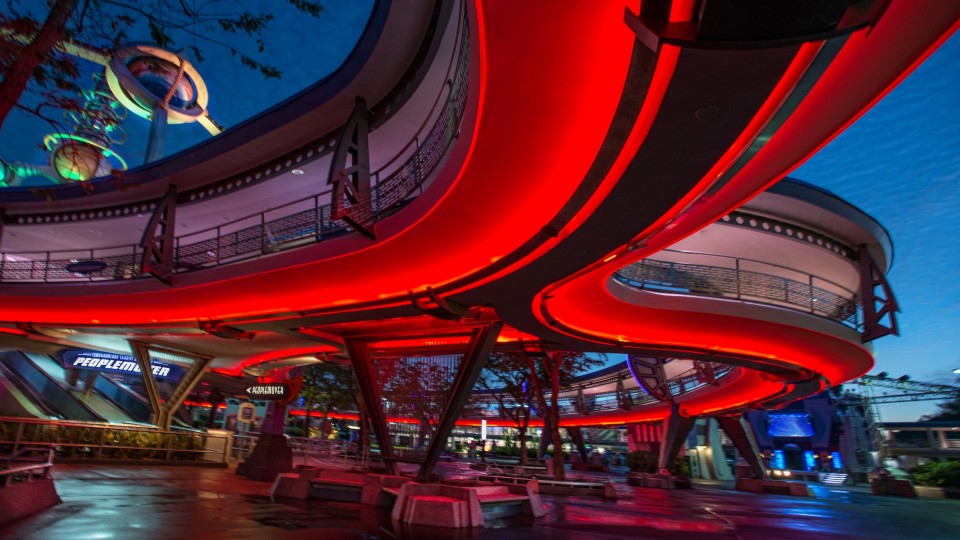
Now to be clear, Magic Kingdom has had a PeopleMover since 1975 – opening alongside the relocated Modern Marvel: Carousel of Progress and Space Mountain. However, the Floridian PeopleMover works a bit differently from Disneyland’s, including a quite different layout (remaining at a steady elevation throughout), uncovered cabs (the entire track is covered instead), and using LIM electromagnetic motors along the course rather than drive tires.
But in this New Tomorrowland, the PeopleMover would be reimagined as the Tomorrowland Transit Authority, cast as the “real” mass transit system of this alien spaceport city. Cleverly, nods to imaginary stations, spurs, and color lines throughout the rebranded ride “built-out” the original mythology of this metropolis. But coolest of all, on-board narration got in on the story, too, with announcements and pages referring not to individual rides, but to the “venues” within the city they inhabited.
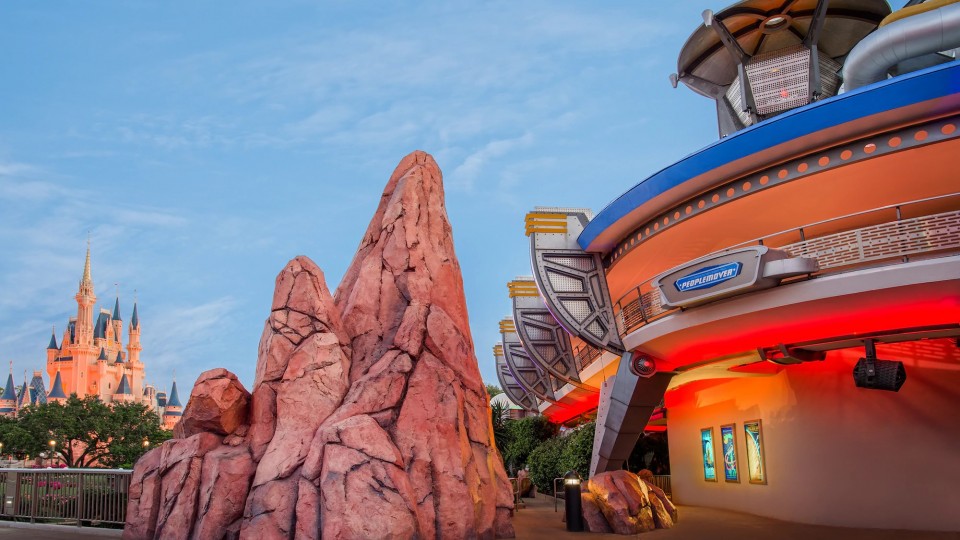
For example, passing by the retrofitted theaters of the Floridian Mission to Mars, the narrator would point out that guests were passing the Tomorrowland Interplanetary Conference Center – nevermind that dystopian alien conglomerate X-S Tech had currently rented it to showcase their new teleportation technology, creating the terrifying Lost Legend: Alien Encounter. Similarly, the Metropolis Science Center offered its current special exhibit, a time travel demonstration alongside the Lost Legend: The Timekeeper.
Granted, this New Tomorrowland didn’t last very long. Its substance was stripped away by a mandated character invasion in the late ’90s, turning Tomorrowland into a catch-all for Monsters Inc., Finding Nemo, Toy Story, and Buzz Lightyear. The pulpy sci-fi style meanwhile, hung on quite a bit longer, and is only now being phased out in favor of (ready for this?) the ’70s simplicitly Disney was once so desperate to cover up. Florida’s ride has been renamed the PeopleMover and continues gliding along the elevated highways of Tomorrowland in Orlando. Meanwhile…
Disneyland: New Tomorrowland (1998)
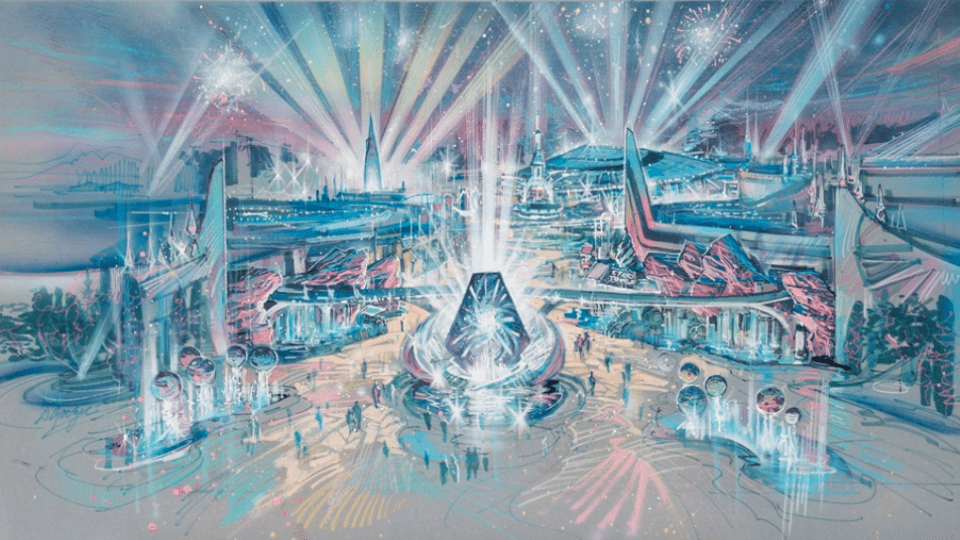
Initially, plans were moving forward with transitioning Disneyland into a sci-fi future, too. In fact, we dove deep into the concepts floated for the never-built Possibilityland: Tomorrowland 2055, looking in awe at glowing alien night parades, extraterrestrial cabarets, alien encounters, and more.
But, as we know, plans changed. The 1992 opening of Disneyland Paris didn’t exactly go over as executives had hoped. In fact, the overbuilt and undervalued park practically caused the cancellation, closure, or downsizing of every single project in the Imagineering pipeline for two decades… including the ambitious Tomorrowland 2055.
With the budget slashed and half of Tomorrowland rotting in plain view, Disney needed to move forward with a New Tomorrowland in California. But now, it would need to be cheap. The solution?
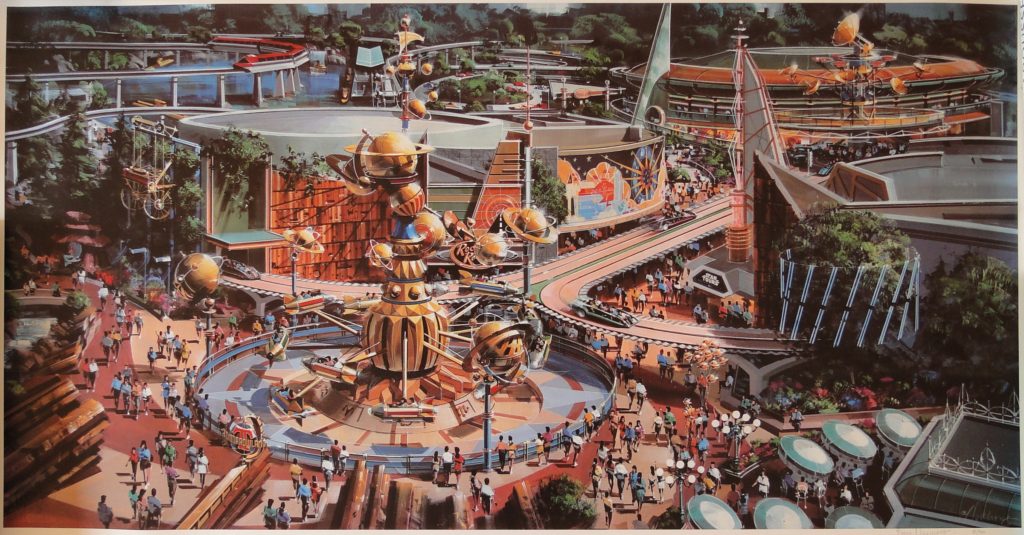
In 1998, Disneyland’s Tomorrowland came out from under the knife looking… well… quite a bit like Discoveryland. In an attempt to reimagine Tomorrowland with as little new research and development as possible, the literary, Jules Verne inspired aesthetic of Paris’ fantasy future came to California (albeit, explained now as an “agri-future”).
Honestly, the idea of diverting the two U.S. Tomorrowlands into sci-fi and fantasy, respectively, is interesting! Unfortunately, the execution of this New Tomorrowland was… well… bad.
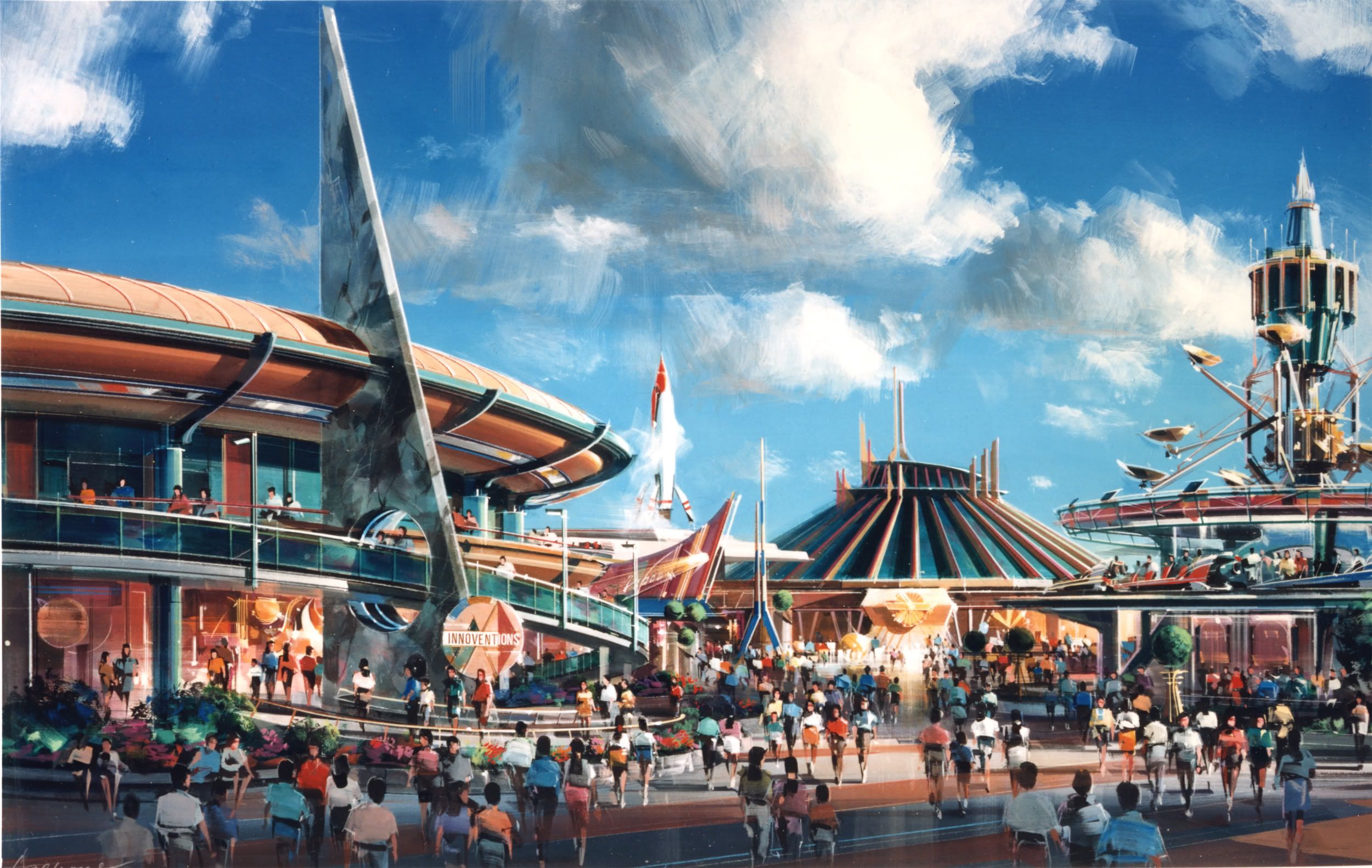
In fact, New Tomorrowland 1998 amounted stylistically to little more than dousing Walt’s 30 year old, Space Age architecture in buckets of dreary brown and copper paint, up-to-and-including Space Mountain. But unlike the custom-built look of Paris’ brass steampunk peak, California’s mountain (and the rest of the land) still looked like mid-century masterpiece… just painted brown.
The Rocket Jets that once revolved high atop a pedestal in the land’s center were grounded. Following in the footsteps of Paris, they were replaced with the earthy Astro Orbitor, set awkwardly at the land’s entrance and surrounded in Discoveryland-style rocks burst forth from the ground. And that was emblematic of the problem. While the beautiful, entrancing Astro Orbitor makes great sense in Paris, the new look of the ride and the rest of the land felt entirely at odds with Star Tours, Space Mountain, and the “new” attraction: Honey, I Shrunk the Audience, none of which made sense in the context of a European retro-future anyway.
Vacant highways


Slide to compare, 1995 v. 1998
But of course, the true tragedy is that this unfortunate redesign also spelled the end for the PeopleMover. The attraction closed forever on August 21, 1995 in anticipation of the land’s makeover. When New Tomorrowland made its debut in May 1998, those elevated tracks throughout the land remained… but now, rather than the elegant and simple pastel trains of the PeopleMover, they would house the revving, squealing, rubber-burning Rocket Rods.
Traversing in three minutes the same course that had taken then PeopleMover sixteen, the Rocket Rods were meant to not only be the anchor attraction of New Tomorrowland, but an adrenaline-packing hot rod thrill ride that would redefine Disneyland.

If you’re in the mood for heartbreak, this would be the time to make the jump to our official, in-depth exploration into the Disaster Files: The Rocket Rods and Tomorrowland 1998 – a sort of sequel to the story of the PeopleMover. The short version of the story is that the Rocket Rods literally didn’t work. Despite being the “starring” prototype technology of New Tomorrowland, the ride’s frazzled computers and blown tires lead to multi-hour waits and days, weeks, and months of closure on-and-off for about two years before Disney officially threw in the towel.
The Rocket Rods may have burned off in a flash, but the heartbreak left in their wake sure hasn’t. And neither has the evidence of this attraction, abandoned in plain sight.
Since its closure (and especially since the closure of the Rocket Rods in 2001), guests and fans have rallied endlessly for the return of the PeopleMover. Occasionally, Imagineers will cryptically state that they recognize fans’ fervor for the ride and mention, “We’re working on it” or “Be patient.” Sometimes, stunning and unthinkable adaptations of the ride track like the one above slip through, suggesting one of our Seven Modern Wonders of the Theme Park World could take to the tracks. But realistically, it doesn’t seem that the PeopleMover will ever be back.
For one, the removal of the Rocket Rods’ bus-bar hardware would be a land-spanning challenge in its own right, much less the installation of new PeopleMover propoulsion and vehicles. More damning, the compelling reason often cited by industry experts is the ride’s relative inaccessibilty under even the baseline requirements of the Americans with Disabilities Act (ADA). In other words, if the PeopleMover were built today (especially in California), it would require widened pathways and guard rails for evacuations, frequent staircases, ADA ramps, and other substantial rebuilds that would inherently impact every showbuilding in the land.
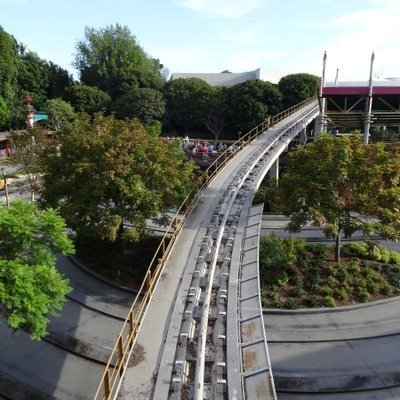
The more likely scenario is that – because of that tangled layout placing track and support structures throughout the land’s buildings – the remains of the PeopleMover are simply too difficult to remove. For that reason, any change to the PeopleMover – be it reimagining or removal – will likely coincide with the next complete renovation of Tomorrowland… whenever and whatever that may be.
Lost Legend
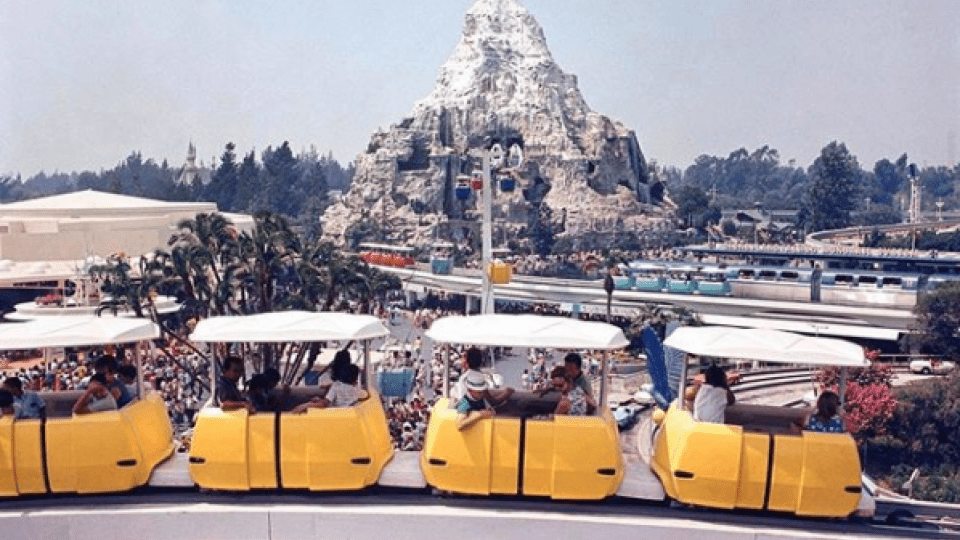
It’s often said, “You don’t know what you’ve got till it’s gone.” That’s probably true of the PeopleMover, a gentle, functional, high-capacity park addition that gave life to Walt’s “World on the Move.” A living prototype of potential mass transportation solutions of tomorrow, this Space Age transit technology was simple, sensational, and spectacular.
Perhaps in part because of its absence, Tomorrowland lacks the optimism, fluidity, motion, and spirit that Walt and his Imagineers had so infused in the land back in 1967. In some ways, the PeopleMover proves that not every starring attraction has to be a thrilling E-Ticket. Perhaps the most appropriate lesson to learn from the case of the PeopleMover is one of the oldest adages in the book: “if it ain’t broke, don’t fix it.”
If you enjoyed this in-depth look at Disneyland’s forgotten highway in the sky, make the jump to our Lost Legends collection and set course for another in-depth feature. Then, share your memories, thoughts, and ideas about the PeopleMover in the comments below.




